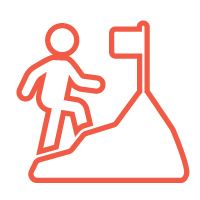- Bewerley Park (view map)
Year Groups
- Primary School
- Secondary School
- Post 16

Duration
Half Day
Difficulty
Adapted to the age and level of experience of students on adventure.
CURRICULUM LINKS
Key Stage 2: Science, Maths
Key Stage 3: Maths
Key Stage 4: Physics
reaching new heights
Take a leap of faith, climb Jacob’s ladder, build and scale wobbly crate tower, and learn how to keep yourself and your friends safe whilst having fun!
Tackled alone or together with classmates, students will learn to manage risk, cooperate, and support each other in a series of high ropes challenges that are sure to get the heart rate pumping.
The level of difficulty of challenges is adapted to the age and level of experience of students on adventure.
What’s Included

All specialist equipment
Climbing helmet and harness.
All specialist clothing
Waterproofs when required.
Experienced, full-time, outdoor teachers and tutors
Each group of 12 students is led by a fully qualified and experienced outdoor tutor.
– back in the classroom –
curriculum links
High ropes pose many challenges to individuals and teams, but it can also be used to help understand key curriculum areas such as physics, with the forces involved or in maths using angles and fractions.
Key Stage 2
Science: Forces
Forces can be used throughout a high ropes session. Links can be made in several ways such as friction and how applying pressure makes a climber less likely to slip, and the forces changing when a student tugs on a rope.
Maths: Measurement
Students can use their maths skills to estimate the course height, the hight they have climbed over the session, and then the combined height climbed by the whole group. Angles can be introduced as a part of the session to help understand the effects of rope angle when belaying a climber.
Key Stage 3
Maths
Fractions can be used throughout a high ropes session as a way of describing the height. This can be used for students setting targets of where they want to get to, then again to review their success and set new objectives for subsequent attempts. Fractions are an excellent descriptor.
Key Stage 4
Physics
Changes in momentum
Students should be able to explain safety features such as airbags and seat belts in a vehicle – this can be likened to a harness, belaying devices, and helmets that are used whilst participating on the high-level ropes course.
LOCATIONS: Bewerley Park
YEAR GROUPS: Suitable for Primary School, Secondary School, and post 16 students

DURATION: Half day activity

DIFFICULTY: Adapted to the age and level of experience of students on adventure
CURRICULUM LINKS:
Key Stage 2: Science, Maths
Key Stage 3: Maths
Key Stage 4: Physics
reaching new heights
Take a leap of faith, climb Jacob’s ladder, build and scale wobbly crate tower, and learn how to keep yourself and your friends safe whilst having fun!
Tackled alone or together with classmates, students will learn to manage risk, cooperate, and support each other in a series of high ropes challenges that are sure to get the heart rate pumping.
The level of difficulty of challenges is adapted to the age and level of experience of students on adventure.
What’s Included?
All specialist equipment
All sporting equipment and adventure specific helmets and harnesses.
All specialist clothing
Waterproofs, wellies and wetsuits, when required. Ideally students should bring their own wellies, but we have plenty on hand to lend.
Transport
Once at the centre, all transport to and from adventure activities is provided.
Experienced, full-time, outdoor teachers and tutors
Each group of 12 students is led by a fully qualified and experienced outdoor tutor.
classroom benefits
curriculum links
High ropes pose many challenges to individuals and teams, but it can also be used to help understand key curriculum areas such as physics, with the forces involved or in maths using angles and fractions.
Key Stage 2
Science: Forces
Forces can be used throughout a high rope’s session. Links can be made in several ways such as between friction and how applying pressure makes a climber less likely to slip, and the forces changing when a student tugs on a rope.
Maths: Measurement
Students can use their maths skills to estimate the course height, the hight they have climbed over the session, and then the combined height climbed by the whole group. Angles can be introduced as a part of the session to help understand the effects of rope angle when belaying a climber.
Key Stage 3
Maths
Fractions can be used throughout a high ropes session as a way of describing the height. This can be used for students setting targets of where they want to get to, then again to review their success and set new objectives for subsequent attempts. Fractions are an excellent descriptor.
Key Stage 4
Physics: Changes in momentum
Students should be able to explain safety features such as airbags and seat belts in a vehicle – this can be likened to a harness, belaying devices, and helmets that are used whilst participating on the high-level ropes course.